剑桥少儿歌曲歌谣培训课件
- 格式:pptx
- 大小:839.91 KB
- 文档页数:7
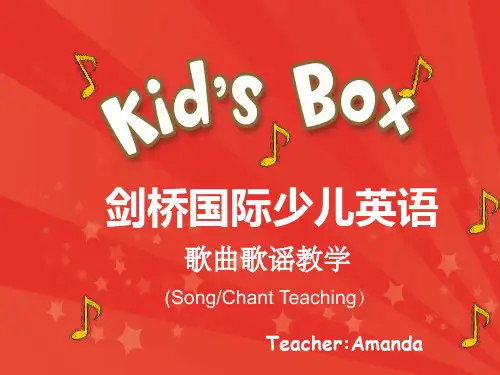
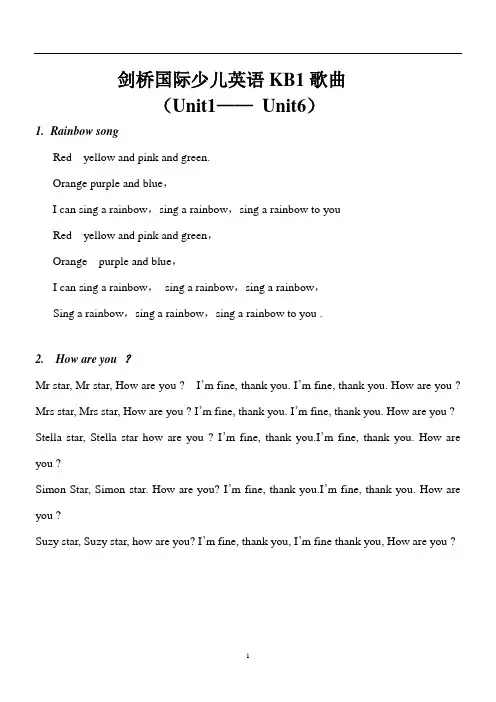
剑桥国际少儿英语KB1歌曲(Unit1——Unit6)1.Rainbow songRed yellow and pink and green.Orange purple and blue,I can sing a rainbow,sing a rainbow,sing a rainbow to youRed yellow and pink and green,Orange purple and blue,I can sing a rainbow,sing a rainbow,sing a rainbow,Sing a rainbow,sing a rainbow,sing a rainbow to you .2. How are you ?Mr star, Mr star, How are you ? I’m fine, thank you. I’m fine, thank you. How are you ? Mrs star, Mrs star, How are you ? I’m fine, thank you. I’m fine, thank you. How are you ? Stella star, Stella star how are you ? I’m fine, thank you.I’m fine, thank you. How are you ?Simon Star, Simon star. How are you? I’m fine, thank you.I’m fine, thank you. How are you ?Suzy star, Suzy star, how are you? I’m fine, thank you, I’m fine thank you, How are you ?3.Where’s Monty ?Monty !Monty isn’t here, Monty isn’t there. He isn’t on the table. He isn’t under the chair.Oh? Where ? Where? Where is Monty ?Is he in the toy box ? Is he under the book ? Is he next to the computer?Look! Look ! Look!Oh, Where ?Where ? Where ? Where ?Where ? Where ? Where ?Where ? Where ?Where’s Monty ?4.We are family!The three children: Young or old, happy or sad. Brother or sisters, mum and dad.Suzy : We are family. My brother, my sister, my brother, my sister and me.Stella: He’s my father, she’s my mother, she’s my sister, and he’s my brother.Suzy : We are family. My brother, my sister, my brother, my sister and me.Simon : She’s my mum, he’s my dad, beautiful, not ugly. Happy not sad.Suzy : We are family. My brother, my sister, my brother, my sister and me.5.My pets !MEERA : My name is Meera, and this is my fish. It’s a long fish. It’s a long fish.LENNY: My name is Lenny. And this is my bird. It’s a happy bird. It’s a happy bird.STELLA: My name is Stella. And this is my cat. It’s a clean cat. It’s a clean cat.SUZY: My name is Suzy. And this is my dog. It’s a big dog. It’s a big dog.MRS STAR: My name is Mrs star. And this is my horse.It’s a beautiful horse. It’s a beautiful horse.SIMON: My name is Simon, And this is my mouse. It’s a small mouse.SUZY: It’s an ugly mouse.SIMON: No, it isn’t.STELLA: It’s a dirty mouse.MEERA: It’s a short mouse.LENNY: It’s a small mouse.ALL : Yes, it’s a small mouse.SIMON : Yes, it is.6.MonsterI’m a very ugly monster, I’m a very ugly monster, I’m a very ugly monster, I’ve got six dirty ears. Yes, I have.I’ve got pink hair, and my eyes are red.I’ve got a blue nose, and a purple head.I’ve got a green mouth, and my teeth are blue.My name is Slime. Who are you ?I’m a very ugly monster, I’m a very ugly monster, I’m a very ugly monster, I’ve got six dirty ears. I’ve got six dirty ears. Yes, I have.。
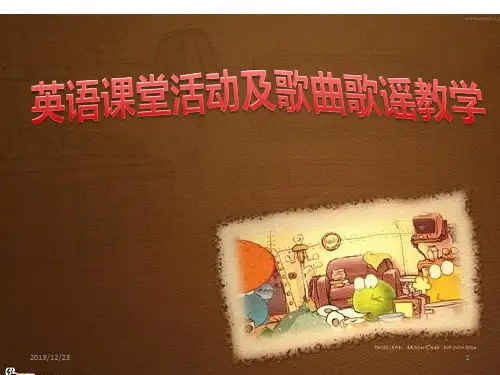
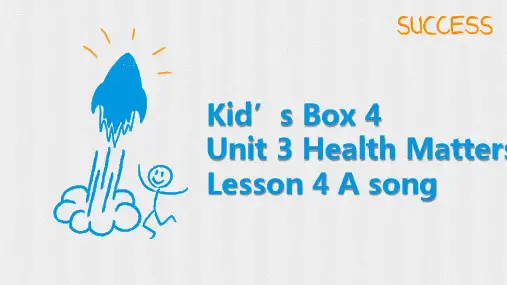


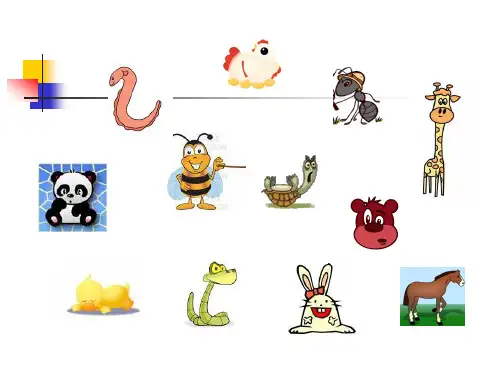



剑桥国际少儿英语全套教学课件目录•Introduction to Cambridge International Children's English •Training of Listening and Speaking Skills•Improving reading and writing skills •Consolidating vocabulary and grammar knowledge•Cultural background and cultivationof cross cultural communicationskills•Establishment of course evaluation 目录and feedback mechanism01 Introduction to Cambridge International Children's EnglishTeaching philosophy and objectives010405060302Textbook System and CharacteristicsApplicable objects and advantages02 Training of Listening and Speaking SkillsListening training strategiesPredictive listening01Selective listening02Intensive listening03Oral expression skillsVocabulary developmentSentence structureFluent deliveryScenario dialogue exampleRole playsInformation gap activitiesConversational exchanges03Improving reading and writing skillsEnhance students to predict what they will read about based on the title, headings, and any accompanying imagesPredicting contentTeach students how to quickly read through a text to get the gift of the information (skimming) and how to search forspecific details (scanning)Skimming and scanningHelp students build their vocabulary by teaching them strategies to see the meaning of unknown words from context clubsUnderstandin g vocabularyGuide students to read between the lines and make references based on what they have readInferring informationReading comprehension methodsWriting Skills GuideRecommendation and comments on model essays04 Consolidating vocabulary and grammar knowledge输入标题02010403Vocabulary memory methods0102TensesNounsAdjectives …PositionsSentence structure030405Summary of grammar pointsPractice question bank and answers Multiple choice questions Gap fill exercisesTranslation exercises Writing prompts05Cultural background and cultivation of cross cultural communication skillsIntroduction to English speaking Counties and CulturesOverview of major English speaking countriesCustoms and conditionsValues and ways of thinkingCross border communication etiquette guidanceBasic communication etiquetteand farewellsDining etiquetteand wine cultureBusiness etiquetteRole playing activities Cultural exchangeactivitiesPracticalapplication tasksDesign and organization of practical activities06 Establishment of course evaluation and feedback mechanismStudent self-assessment report templateDesign of self-assessment questionsincluding speaking, listening, reading, writing, and other aspects tocomprehensively evaluate students' English proficiencyRegular submission of self-assessment reportsrequesting students to submit self-assessment reports on a regular basis tohelp teachers understand students' learning progress and differencesGuidance and feedback on self-assessmentteachers provide guidance and feedback on students' self-assessment reportsto help students improve their learning methods and strategiesConstruction of Teacher Evaluation Index System Establishment of evaluation criteriaCollection and analysis of evaluation dataFeedback and improvement measuresParental feedback channel settingsEstablishment of parent feedback channelsCollection and handling of parental feedbackFeedback and communication with parentsTHANKS 感谢观看。
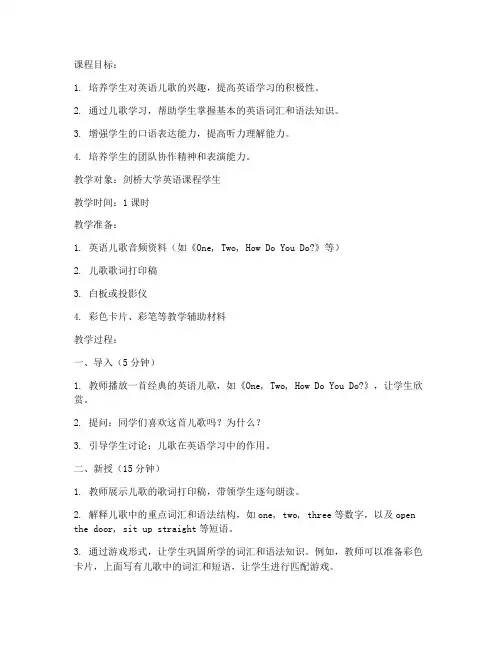
课程目标:1. 培养学生对英语儿歌的兴趣,提高英语学习的积极性。
2. 通过儿歌学习,帮助学生掌握基本的英语词汇和语法知识。
3. 增强学生的口语表达能力,提高听力理解能力。
4. 培养学生的团队协作精神和表演能力。
教学对象:剑桥大学英语课程学生教学时间:1课时教学准备:1. 英语儿歌音频资料(如《One, Two, How Do You Do?》等)2. 儿歌歌词打印稿3. 白板或投影仪4. 彩色卡片、彩笔等教学辅助材料教学过程:一、导入(5分钟)1. 教师播放一首经典的英语儿歌,如《One, Two, How Do You Do?》,让学生欣赏。
2. 提问:同学们喜欢这首儿歌吗?为什么?3. 引导学生讨论:儿歌在英语学习中的作用。
二、新授(15分钟)1. 教师展示儿歌的歌词打印稿,带领学生逐句朗读。
2. 解释儿歌中的重点词汇和语法结构,如one, two, three等数字,以及open the door, sit up straight等短语。
3. 通过游戏形式,让学生巩固所学的词汇和语法知识。
例如,教师可以准备彩色卡片,上面写有儿歌中的词汇和短语,让学生进行匹配游戏。
三、实践(20分钟)1. 教师播放儿歌音频,让学生跟唱,注意发音和节奏。
2. 分组练习:将学生分成小组,每组选择一首儿歌进行练习,要求学生用自己的语言进行表演。
3. 小组展示:每组派代表上台表演,其他小组进行点评。
四、总结(10分钟)1. 教师对学生的表现进行点评,表扬优秀的小组和个人。
2. 引导学生总结:通过学习儿歌,我们学到了哪些英语知识?3. 鼓励学生在日常生活中多听、多唱英语儿歌,提高英语水平。
教学反思:1. 本节课通过儿歌教学,激发了学生的学习兴趣,提高了英语学习的积极性。
2. 学生在实践环节中,不仅掌握了英语知识,还锻炼了口语表达能力和团队协作精神。
3. 教师应注重激发学生的学习兴趣,结合学生的实际情况,设计有趣的教学活动。
课时:2课时年级:小学四年级教学目标:1. 通过学习英语儿歌,提高学生的英语口语表达能力。
2. 培养学生的音乐节奏感,提高学生的音乐素养。
3. 增强学生之间的团队合作精神,提高学生的团队协作能力。
教学重点:1. 英语儿歌的演唱。
2. 儿歌中的律动动作。
教学难点:1. 儿歌中的节奏把握。
2. 动作的协调性。
教学准备:1. 英语儿歌《One, Two, How Do You Do?》等。
2. 音乐播放设备。
3. 学生座位编排,方便团队合作。
教学过程:第一课时:一、导入1. 教师用简单的英语问候学生,激发学生学习兴趣。
2. 引导学生回顾上节课所学内容,复习英语基础。
二、新课导入1. 教师播放《One, Two, How Do You Do?》等英语儿歌,让学生欣赏。
2. 学生跟唱,教师适时纠正发音。
三、学习儿歌1. 教师讲解儿歌的歌词和节奏。
2. 学生跟唱,教师指导学生注意节奏和发音。
四、律动动作1. 教师示范儿歌中的律动动作。
2. 学生跟随教师学习动作,注意动作的协调性。
五、小组合作1. 将学生分成若干小组,每组选一名组长。
2. 每组学生共同练习儿歌的演唱和律动动作。
3. 教师巡回指导,纠正学生的动作和发音。
六、展示1. 每组选派一名代表进行展示。
2. 其他学生观摩,学习展示小组的优点。
第二课时:一、复习1. 教师带领学生复习上节课所学内容。
2. 学生跟唱,教师纠正发音。
二、拓展1. 教师播放其他英语儿歌,让学生欣赏。
2. 学生跟唱,教师讲解儿歌的背景和特点。
三、分组练习1. 学生分成若干小组,每组选择一首英语儿歌进行练习。
2. 教师指导学生注意歌曲的节奏和发音。
四、展示1. 每组选派一名代表进行展示。
2. 其他学生观摩,学习展示小组的优点。
五、总结1. 教师对本节课进行总结,强调学习英语儿歌的重要性。
2. 学生分享学习心得,教师给予鼓励。
教学反思:本节课通过英语儿歌的学习,提高了学生的英语口语表达能力,培养了学生的音乐节奏感。